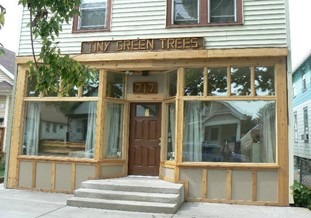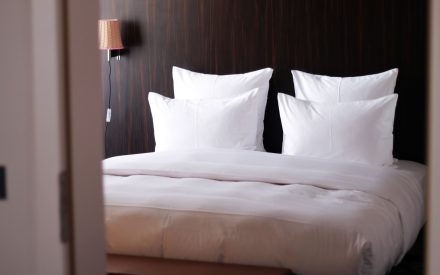March 2015 — Do downtown storefront improvement projects provide an adequate return to the property owners, outside investors, or public funding entities? If so, what are the returns in both economic and other terms?
This article summarizes findings from 24 case studies of storefront improvement projects in Wisconsin over the past 15 years. While not a scientific sample, the findings are consistent with an earlier 1986 study and reflect a spectrum of outcomes that may result from storefront investments.
1. Business operators generally experience an increase in number of first- time customers.
As a result of storefront improvements, over 80% of reporting businesses experienced an increase in number of first-time customers. In addition, previously unoccupied space generated new customers as a result of new commercial tenants. Consistent with the 1986 study, most case study respondents reported positive publicity and recognition for the business, which contributed to interest from new first-time customers.
2. Business operators generally experience an increase in number of first-time customers.
Related to the above and consistent with the 1986 study, over 90% of existing businesses reported an increase in sales. For case studies where data was available, sales revenue increased an average of 20%. However, a few business owners who monitored sales performance before and after storefront improvements reported no change in sales. Restaurant owners experienced the greatest amount of increase, followed by those in the personal and professional service sectors.
3. Property landlords generally generate increased rental revenues.
A few of the case studies represented property owners who reported new rental income. Some of the most significant economic returns were realized by property owners who were able to lease previously unoccupied space as a result of storefront improvements. In a few case studies, apartments were rented as a result of the building’s improved appearance.
4. Properties are often converted to a perceived better use.
A few buildings were repurposed to accommodate different type of tenants in response to market needs. These new tenants often helped stabilize the income stream of the property. Consistent with the 1986 study, exterior storefront improvements were often conducted with other changes in the building to accommodate the new use.

5. Other building improvements, including interior redesign, are often performed simultaneously.
Consistent with the 1986 study, many of the projects included concurrent interior renovations and building improvements. Many building owners found efficiencies in combining exterior and interior work (although façade improvement expenses were isolated to the extent possible in this analysis).
6. Even small investments can generate significant returns.
The projects examined in this study ranged widely in investment outlay (from less than $3,000 to more than $600,000). Consistent with the 1986 study, improvements are often relatively inexpensive. Often very small outlays had significant impact on sales and rent income.
7. Multiple funding sources are often assembled to cover project costs.
Most of the case studies involved numerous sources of funding. In addition to the owner’s investment, 50% of the projects used local incentive grant or loan programs (for façade, signage, or business improvements). Traditional bank loans were also used by 50% of the projects. Historic tax credits were used in a few projects. A few of the case studies involved buildings that were improved because of the availability of storefront improvement funding mechanisms.
8. Property owners generally believe that their building value has increased.
While not asked outright in the case study research, a number of respondents indicated that their property value has or is expected to increase as a result of the improvements. This was an important outcome for a few who anticipated selling their property in the near future. However, accordingly to the 1986 study, property tax increases are minimal (if any) for façade improvements.
9. Nearby businesses often enjoy increased sales and may initiate their own storefront improvements.
A number of case studies demonstrated how new customers attracted to an improved building can positively affect other nearby buildings and their businesses. This was especially true in cases where an unoccupied building regained a commercial tenant. The indirect returns to the surrounding business district were amplified when the improved building was occupied by a tenant that generated foot traffic and complemented other nearby businesses. There were also numerous examples of how an improved building inspired other nearby building owners to consider improvements.
10. Community pride, historic appreciation, and civic legacy are celebrated.
Many local property owners’ attachment to their community’s heritage became a driver in storefront improvement projects. Many property owners expressed a desire to restore their building to its original elegance as a symbol of the community’s heritage. These property owners recognize the unique market opportunities available through the improvement of the community’s original and authentic business district.
This article was prepared by Bill Ryan, Amy Greil, and Dayna Sarver of the University of Wisconsin-Extension, working in partnership with Joe Lawniczak and Errin Welty of the Wisconsin Economic Development Corporation. This analysis builds upon an earlier University of Wisconsin-Extension study performed by Robert N. Dick, Bruce H. Murray, and Ayse Somersan titled Economic Effects of Storefront Improvement: A Report of a 1986 Study of Wisconsin Retail Businesses Which Had Made Façade Improvements during the Previous Five Years.



 Rural Pharmacies an Overlooked Piece of the Rural Health Care System
Rural Pharmacies an Overlooked Piece of the Rural Health Care System The Economics of Downtown Revitalization: Putting Some “Oomph” Behind the Numbers
The Economics of Downtown Revitalization: Putting Some “Oomph” Behind the Numbers The Hotel Industry: Recovery and Future Development in Our Communities
The Hotel Industry: Recovery and Future Development in Our Communities Focus Group Analysis Tips
Focus Group Analysis Tips


